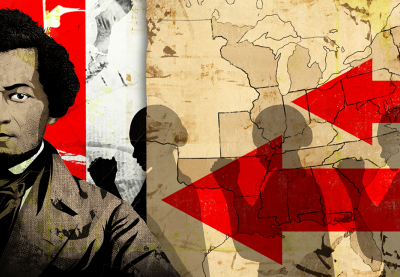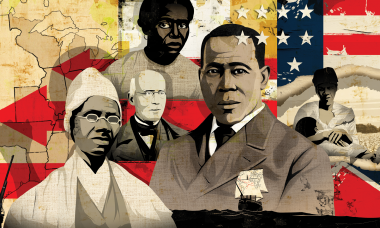A subset of the Hard History project
“All Our Terrible and Beautiful History”: Teach American History as a Human Story
Print this Article
Would you like to print the images in this article?

Editor's note: This passage serves as the introduction to Teaching Hard History: American Slavery—a new report from the Southern Poverty Law Center that reveals a broad failure of textbooks, state standards and pedagogy to adequately address this critical topic with students.
This thorough and unprecedented report lays out clearly some 10 “key concepts,” as well as seven “key problems” for teachers and curriculum directors to digest. And they must digest these through study and learning. I applaud the Teaching Tolerance program's clear-eyed, unafraid quest to name these concepts and problems. They provide a wonderful guide for teachers, as they will also stimulate debate. I also admire the remarkable surveys conducted here; this is a data-driven report and set of prescriptions. It invites new learning and new pedagogy as it also prompts open discussion of how to face this past and gladly, not timidly, teach it. Many of the results are depressing; such surveys almost always are a testimony of ignorance. But therein lies the challenge. Such ignorance of American history is hardly confined to students and American classrooms; it is vividly on display in high offices today in our government.
From directing summer teacher institutes on the history of slavery and abolition for more than 20 years, and from more than 40 years of teaching, first as a public school teacher in Flint, Michigan, for seven years, and then at four different colleges and universities since the 1980s, I can attest to how hungry and needy so many teachers are for knowledge and guidance in this field. We have to feed that hunger, as we also educate both students and teachers. Teachers need what in educational circles is so often called "content." That means good history, history that does not try to teach to already well-rehearsed simple narratives about American triumphalism, but helps teachers learn and face the difficult, hard questions of our past—slavery, exploitation, violence, dispossession, discrimination and the work that has been done to overcome or thwart those realities. Past and present are always connected in any people's history; they flow into one another, often in unseen ways, but also in moments of shock and recognition. When it comes to issues of race and the legacies of slavery in America, we are frequently reminded of these truths.
Slavery is not an aberration in American history; it is at the heart of our history, a main event, a central foundational story. Slavery is also ancient; it has existed in all cultures and in all times. Slavery has always tended to evolve in circumstances of an abundance of land or resources, and a scarcity and, therefore, demand for labor. It still exists today in myriad forms the world struggles to fight. The difference in the 21st century is that virtually all forms of trafficking and enslavement today exist in a world where they are illegal. For the two and a half centuries in which American slavery evolved, the systems of slavery operated largely as thoroughly legal practice, buttressed by local law and by the United States Constitution.
In America, our preferred, deep national narratives tend to teach our young that despite our problems in the past, we have been a nation of freedom-loving, inclusive people, accepting the immigrant into the country of multi-ethnic diversity. Our diversity has made us strong; that cannot be denied. But that "composite nation," as Frederick Douglass called it in the 1870s—a dream and not yet a reality—emerged from generations of what can best be called tyranny. When one studies slavery long enough, in the words of the great scholar David Brion Davis, "we come to realize that tyranny is a central theme of American history, that racial exploitation and racial conflict have been part of the DNA of American culture." Freedom and tyranny, wrapped in the same historical bundle, feeding upon and making one another, created by the late 18th century a remarkably original nation dedicated to Thomas Jefferson's idea of the "truths" of natural rights, popular sovereignty, the right of revolution, and human equality, but also built as an edifice designed to protect and expand chattel slavery. Americans do not always like to face the contradictions in their past, but in so many ways, we are our contradictions.
Of all the reasons or justifications used to enslave other human beings, race was late to the long story. Racial slavery came out of the epoch of the slave trade, which of course lasted four centuries in the Atlantic, and likely longer in the Indian Ocean. That said, teachers need to know more of how to tell that story of why slavery became racial in the Americas, and then in the United States. Slavery was not born racial as some kind of original sin; it was made so by people in historical time. Slavery has many roots—economic, social, moral, religious, political and, yes, racial. All can be taught to young people because they can see similar impulses today. This report calls on all involved to learn and teach the history of white supremacist ideology, which provides one of the deep roots of slavery. As the writer Ta-Nehisi Coates argued in 2015, "Race is the child of racism, not the father." We have a problem of "race" because we have such a long history of making it, of demonstrating how adaptive theories of racial superiority have been to those who would exploit them.
The biggest obstacle to teaching slavery effectively in America is the deep, abiding American need to conceive of and understand our history as "progress," as the story of a people and a nation that always sought the improvement of mankind, the advancement of liberty and justice, the broadening of pursuits of happiness for all. While there are many real threads to this story—about immigration, about our creeds and ideologies, and about race and emancipation and civil rights, there is also the broad, untidy underside. This is the second of the "key problems" identified in this report, and in the long run, possibly the most challenging.
The point is not to teach American history as a chronicle of shame and oppression. Far from it. The point is to tell American history as a story of real human beings, of power, of vast economic and geographical expansion, of great achievements as well as great dispossession, of human brutality and human reform. The point is also not to merely seek the story of what we are not, but of what we are—a land and a nation built in great part out of the economic and political systems forged in or because of slavery and its expansion. Slavery has much to do with the making of the United States. This can and should be told as a story about human nature generally, and about this place in time specifically. Americans were not and are not inherently racist or slaveholding. We have a history that made our circumstances, as it also at times unmade them. Enslaved Americans were by no means only the brutalized victims of two and a half centuries of oppression; they were a people, of many cultures, who survived, created, imagined and built their worlds. And through the Civil War and emancipation, they had much to do with remaking the United States at its refounding in the 1860s and 1870s.
For young people it is essential that, in learning about this difficult subject, we help them understand that very little about history is determined. History does not happen because of prescriptions etched into our lives and behavior. As humans, we do have many disturbing habits and tendencies. But history is also full of great change. "Change does not roll in on the wheels of inevitability," wrote Martin Luther King Jr. Change comes because we make it come. The history of slavery is not merely a depressing subject about exploiters and victims, racists and heroic survivors. It is all of those things, but is also a great place to begin to understand our human condition, our nation's foundations and legacies all round us with which we live every day. Slavery helped make America—to build it—and through cataclysms, its destruction made possible remaking America. In 1959, surveying how Americans think about their past, James Baldwin wrote that "all our terrible and beautiful history" can seem like it binds us down, that we are "doomed to an unimaginable unreality." But he refused to accept that conclusion, no matter how "hard" the history. "I prefer to believe," said Baldwin, "that the day is coming when we will tell the truth about it—and ourselves. On that day … we can call ourselves free men."
Based on the research in Teaching Hard History—and the feedback of experts, teachers and students—Teaching Tolerance has developed a collection of materials to support effective and responsive teaching about American slavery. These include teaching tools, like A Framework for Teaching American Slavery and Inquiry Design Models; the Teaching Hard History Text Library, an online archive featuring more than 100 primary source documents to support robust teaching and learning about American slavery; a podcast series hosted by Professor Jeffries and featuring the voices of leading scholars and educators in the field; and an upcoming webinar from our teaching and learning team.
Blight is Class of 1954 Professor of American History and director of the Gilder Lehrman Center for the Study of Slavery, Resistance and Abolition at Yale University. He is the author of Frederick Douglass: Prophet of Freedom, forthcoming from Simon and Schuster.
Print this Article
Would you like to print the images in this article?
